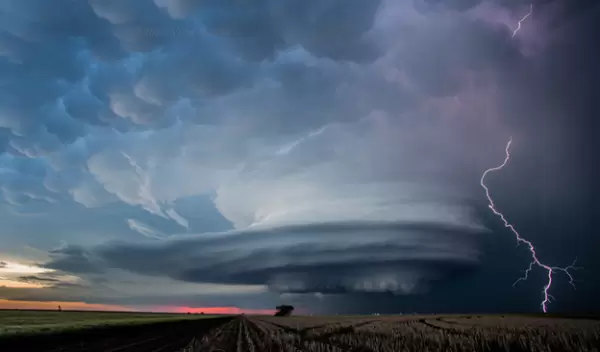
Scientists hone long-range forecasting of U.S. tornadoes, hail
Scientists at Northern Illinois University are honing extended-range weather forecasting, identifying patterns halfway around the globe that will heighten the probability of hail- and tornado-producing storms in the United States weeks later.
The U.S. National Science Foundation-supported research identifies specific orientations of atmospheric phenomena occurring near the equator over the Maritime Continent that increase the probability of severe U.S. weather events three to four weeks later. Using the information to create extended-range forecasts would provide more time to raise awareness of severe weather and potentially save lives and property.
Combing through data from 1979 to 2019, the scientists found 100 instances of significant fluctuations that had occurred in the Madden-Julian Oscillation, or MJO -- a major disturbance of wind, rain and pressure -- and looked for correlations with severe U.S. weather weeks later.
"Meteorologists refer to the Madden-Julian Oscillation as part of a teleconnection, which means that the weather happening in one part of the globe can eventually have an impact thousands of miles away," said Nick Anderson, a program director in NSF's Division of Atmospheric and Geospace Sciences. "This research shows the role of data science in interpreting those connections with the goal of improving forecasting on longer lead times."
As an MJO moves eastward along the equator, it can weaken or strengthen as it crosses the islands of the Maritime Continent, which include Indonesia and the Philippines. Of the 100 identified MJO fluctuations, 53 of these storm clusters gained strength as they crossed the Maritime Continent and entered the Pacific Ocean, causing ripples in the atmosphere and eventually changing circulation patterns over North America.
"These 53 events showcased the largest probabilities for increasing U.S. tornado and hail activity in the following three to four weeks," said the study's lead author, Douglas Miller. "Different MJO characteristics led to different timing and changes in severe weather activity."
The study -- co-authored with NIU meteorologist Victor Gensini and Bradford Barrett of the U.S. Air Force Office of Scientific Research -- is published in the journal Climate and Atmospheric Science.
The researchers used machine learning to separate characteristics of the 53 storm clusters according to location, strength and propagation speed. Composites of the clusters were then categorized as one of three "flavors" -- weak, slow or fast.
All three types heightened probabilities of increased U.S. tornado and hail events, but different flavors took different paths, Miller said, with the slowly propagating MJO clusters providing the best "forecast of opportunity" for severe convective storms in the U.S.


